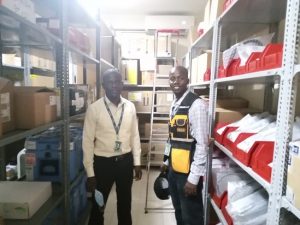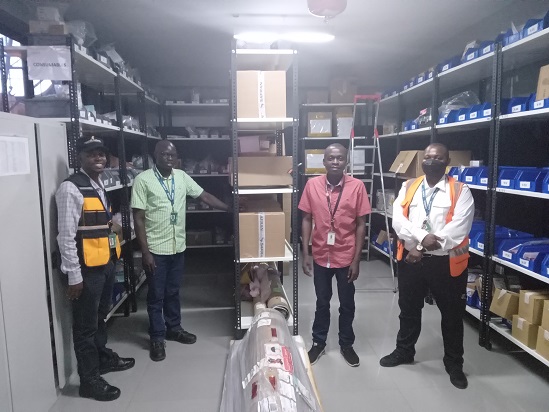Uganda Airlines Engineers inside one of the stores
The aviation industry is one of the most regulated industries across the world.
It is also an industry understood by a few people. This perhaps explains why many Ugandans including MPs questioned Uganda Airlines’ move to buy a new spare (reserve) engine for the Bombardier CRJ900.
A new CRJ engine approximately costs USD 7.5m (about UShs26.8bn).
Why would a new aircraft (CRJ) require a new spare/reserve engine? Did Uganda Airlines, the country’s flag carrier buy old or fake aircraft?
Those are some of the questions Ugandans have lately been asking.
With the ongoing hullabaloo about the CRJ engine, our reporters on Thursday May 05, 2022 visited Uganda Airlines’ Maintenance Department at Eagle Air Hangar Complex in Entebbe to understand more about the operations of the national carrier and what goes on behind the scenes before planes take off to the skies.
Eng. Richard Gayira, Manager Engineering & Planning and Eng. Joseph Lukwago, Manager Maintenance Engineering, led a team of Aircraft Engineers including Richard Bagonza and Wilson Kimeu, the head of Maintenance Control Centre (MCC) to take us through the critical role of Maintenance Department and why spare/reserve parts are critical for any airline if it is to succeed.

It’s worth noting that Uganda Airlines fleet consists of two (2) Airbus A330-800 Neo and four (4) Bombardier CRJ900.
Eng. Gayira explained that Uganda Airlines’ Maintenance Department is subdivided into three sections; maintenance section, Engineering planning section and Materials section.
The entire Maintenance department which is headed by Director Maintenance and Engineering Engineer (Eng. Ephraim Bagenda), has 25 staff including three managers, 12 licensed maintenance engineers, four development engineers, two aircraft technical records officers and 4 technical stores.
All of them are Ugandans except two who are Kenyans.
These have since completed the CRJ900 and A330-800neo aircraft type trainings.
Gayira says aircraft maintenance is highly regulated to ensure safe and correct functioning during flight.
In civil aviation, he says, national regulations are coordinated under international standards set by ICAO (International Civil Aviation Organisation).
ICAO standards have to be implemented by the local Authority (Uganda Civil Aviation Authority) to regulate the industry
He explains that Airlines prepare for maintenance by recruiting qualified personnel (maintenance staff must be licensed and certified for the tasks they carry out), having in place inspection systems & documentation and adequate maintenance facilities.
He says that as they carry out maintenance on the aircraft, they are guided by the Approved Maintenance Program (AMP).
“This is a manual developed from Aircraft/Aircraft component manufacturers e.g Maintenance Planning Document and is approved by UCAA,” he says.
He further explains that they carryout scheduled and unscheduled maintenance tasks.
Scheduled maintenance tasks include periodic inspections that have to be done on an aircraft after a certain number of flight hours or landings or calendar days.
Gayira says after every maintenance task is completed, a person authorised by the national authority signs a maintenance release (CRS) stating that “maintenance has been performed in accordance with applicable airworthiness requirements”.
”Aircraft maintenance in civil aviation is generally organized using a maintenance checks system,” he says.
AOG Situations
Eng. Lukwago explains that Aircraft On Ground (AOG) can result from bird strikes, lightening strikes and hard landings among others. When this happens, unscheduled maintenance has to take place.
“In the airline industry, these are situations beyond our control that we need to brace ourselves for during operations. These have affected many other airlines here in Entebbe airport and elsewhere,” Lukwago says, adding: “Never the less, we have engineers, equipment, facilities, spares, procedures and partners lined up to see us through all these situations,” he says.
Preparations for AMO
He adds that maintenance offices, battery shops, equipment shed and stores in readiness for Uganda Airlines Approved Maintenance Organization (AMO) project have been constructed and are still being developed for both short term and the long term.
Eng. Lukwago and team gave us a guided tour of the facilities and equipment already in place as the national carrier gears up for the AMO approval and certification.
The procured equipment include scissor lift, cherry picker, compressor wash equipment, exterior wash equipment, modern maintenance platforms, borescope equipment, pitot static test equipment, ATC transponder equipment and hangar equipment that includes tripod jack, among others.
“This equips us for both line maintenance and base maintenance to ensure continuity of operations,” he says.

With an in-house AMO, Uganda Airlines will significantly cut maintenance costs as money currently being spent on contracted AMOs will be saved. The national carrier will also make extra revenue from other airlines by offering maintenance services to them.
It should be noted that Uganda Airlines has a signed maintenance contract with SAMCO which is approved by UCAA at their base in Maastricht and the line maintenance station in Entebbe. This is specifically for the CRJ900.
The national carrier also contracted SAAT (South African Airways Technical) which is also approved by UCAA at their base in Johannesburg and the line maintenance station in Entebbe. This is for the Airbus.
Gayira however says the ultimate responsibility for aircraft maintenance and airworthiness of the aircraft is for the operator. “Whether you contract a third party or AMO to do maintenance of your aircraft, you are overall responsible. That means you must have structures in place,” he says, adding: “So you need to be following up on what this contracted AMO is doing. You need to ensure that all the maintenance requirements and procedures are satisfied per regulatory requirements.”
Gayira says Uganda Airlines should have its AMO certification by the 4th quarter of 2022 (December 2022).
He says the national carrier is set to recruit 14 more engineers and these will include four MCC engineers.
“In 6 to 8 months from today, Engineers will be ready for certification and authorization on the CRJ900 aircraft,” he says, adding: “For in-house AMO, some of these staff will be assigned AMO management roles (as AMO Base maintenance manager, Quality Manager, Safety Manager and Workshop Manager). This is a regulatory requirement.”
He adds that additional Maintenance Staff; Technical Assistants and Maintenance Cabin Groomers have been recruited and are undergoing induction.
“These will ensure exhaustive maintenance of aircraft interior ambiance, exterior cleanliness and equipment maintenance,” he says.
Spare Parts and Why Reserve Engine is important
As far as spares are concerned, Eng. Gayira says they have “NO-GO items and GO IF items” as per the maintenance operations guidelines.
“With this categorisation of aircraft parts and components, we avoid stocking what we don’t need urgently but we ensure we can access them in time,” he says, adding that “We stock those items that can immediately ground aircraft otherwise we shall have a whole aircraft in the stores, which is not financially feasible.”

”We tow the safe line being safety conscious and economically viable,” Eng. Gayira says.
He says Uganda Airlines needs a spare/reserve engine for the Bombardier CRJ900 because failure to have it can easily result into the grounding of the aircraft.
“You need a reserve engine because when one of the aircraft engines has a problem, you just replace it as the other is being repaired. Otherwise without a spare engine, you risk being grounded,” Eng. Gayira says, adding that once they get a spare engine, it will be used to attain stagger within the fleet to avoid all aircraft being due for scheduled maintenance and at the same time cater for need of engine replacements for whatever reason.
He adds that renting (leasing) an engine from registered suppliers (lessors and/or the engine manufacturer) is quite expensive because they charge per flight hour.
“You don’t know when for example a bird strike that can damage the engine will happen. To avoid being grounded, you need a reserve engine,” he says.
Asked if they have a reserve engine for the Airbus A330-800 Neo, Eng. Gayira said Uganda Airlines has a Total Care Agreement with Rolls-Royce to provide spare engine/s for Airbus whenever needed.
The Engineers also revealed that a well serviced and maintained aircraft can live up to 30 years.

Uganda Airlines also has an arrangement with suppliers of spares to keep a minimum of critical spares (mainly NO-GO/AOG) at the airline’s Entebbe base to ensure minimum ground time between aircraft technical defects.
”We also have pool arrangements where component support agreements are signed with spare parts suppliers – Lufthansa’ Technik for CRJ900 and Airbus FHS for A330neo.
We order from a spare parts pool with convenient locations all over the world to pick up spares when need arises,” Eng. Gayira said, adding: “We also have our own spares in our stores to keep us going.
The above arrangements are regulatory and convenient for us as far as spares for aircraft are concerned.”






